There are many edibles that are barely known and near the top of that list would be the Osage Orange. Not an orange and actually closely related bread fruit and paper mulberries, the Osage Orange is an extremely common native tree in parts of the mid-western United States. Thanks to government intervention it is the most intentionally planted tree in the United States.
Because the fruit is large farm animals often choked on them leading to the belief they are toxic. They are not although they do a good job at repelling insects. If the fruit is broken up many animals can eat it. And the seeds are edible for us humans after processing One archaeological project found it was easier to locate old homesteds by finding Osage Orange trees rather than abandoned wells. The tree has many uses and is highly esteemed for making bows. While teaching a foraging class in Jacksonville this weekend one person mentioned there was one growing near where she lived. An excursion was in order and indeed it is an Osage Orange. I brought some home to work with. To read more about the Osage Orange go here.
Rotten cheese soaked in tobacco juice. That’s how Jonathan Dickerson described the taste of saw palmetto berries in 1692 and they haven’t changed since. Nutritious, they”ll be coming into season soon. Most of the fruit I see now are full-sized but green. In two to six weeks they’ll turn golden then black. That’s when they’re good, in theory. If tastes are acquired, then saw palmetto berries is a very acquired taste. I think I am the only person on video in the world actually eating one. My article on them is here. That said they are a $70 million plus crop in Florida and a major source of poaching arrests and deaths as well. It can get up to about 115 F in pine scrubs where they grow, they are covered with sharp thorns (hence the “saw” in saw palmetto) hide nests of wasps and are the favorite hot day retreat of rattle snakes. Not exactly a work-friendly environment. If you are tempted to pick some always… ALWAYS… rattle the palm first with a long stick to any rattlers can slither off.
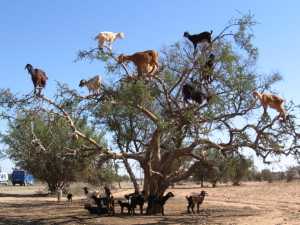 New foraging instructors have been added to the collection on my “resource” page. It now lists over 100 teachers both in North American and Europe. The list started out much smaller in a book by Dr. Peter Gail then moved over to a website by Sunny Savage where it grew. It’s been expanded, had pictures added, and has been on this site for some five years now. It might be the most comprehensive list of foraging teachers on the planet! However, several states still do not have any teachers mentioned so if you know of some please let me know. To visit the page click here.
New foraging instructors have been added to the collection on my “resource” page. It now lists over 100 teachers both in North American and Europe. The list started out much smaller in a book by Dr. Peter Gail then moved over to a website by Sunny Savage where it grew. It’s been expanded, had pictures added, and has been on this site for some five years now. It might be the most comprehensive list of foraging teachers on the planet! However, several states still do not have any teachers mentioned so if you know of some please let me know. To visit the page click here.
Foraging classes this week: Saturday, Aug 10th., John Chestnut State Park: 2200 East Lake Road, Palm Harbor, FL 34685, 9 a.m; Sunday, Aug. 11th, Mead Garden, 1500 S. Denning Dr., Winter Park, FL 32789, 9 a.m; Saturday, Aug 17th, Dreher Park, 1310 Southern Blvd., West Palm Beach, FL, 33405, 9 a.m; Sunday, August 18th, Bayshore Live Oak Park, 23157 Bayshore Rd., Port Charlotte, FL 33980, 9 a.m;Satuday, August 24th, Colby-Alderman Park, 1099 Massachusetts Street, Cassadaga. Fla. 32706, 9 a.m. For more details go here
Recent rains have brought out mushrooms but most of what I’ve found so far is not edible. The toxic False Green Parasol (Chlorophyllum molybdites) has been popping upon on lawns and fields. It is the source of the most common non-deadly mushroom poisonings in North America because it looks similar to an edible one but it has green spores. In fact I just started two facebook group pages, Florida Mushroom Identification Forum and Southeastern US Mushroom Identification. It’s the only mushroom on them so far but that will change. Can’t do everything at once. I also found a large tan boletus in Winter Park that does not have a common name (Tylopilus tabacinus.) It’s in a genus not known as deadly but this particular mushroom’s edibility is unknown which means leave it alone. And in Jacksonville I saw a wonderful clump of Collybia luxurians whose edibility is also unknown. The only edible mushroom I found this week was one old “Gilled Bolete” Phylloporus rhodoxanthus ssp. americanus growing under Southern Cedars in Port Orange. Never try to identify for consumption any mushroom from pictures on the internet. Mushrooms are a context heavy identification often involving minute details. That needs to be done in person with an instructor.
And as Paul Harvey used to say, “for what it’s worth…” A man walks into a bar with a hamburger… no, that’s an old joke. Let’s update it: A man tries to walk onto an airplane with a hamburger, a Kentucky Fried Chicken hamburger. That alone should give one cause to pause. Actually when the burger in a KFC bag went through the x-ray machine the operator saw unusual corners. It wasn’t a beef burger. It was a turtle burger. The turtle was alive. In a hamburger bun. Swimming with relish… The passenger said he didn’t want to leave his beloved pet turtle behind. Authorities separated the… turtle dove and sent him on his way terrapinless. I have various articles on my website about eating various animals which is part of the “other thing, too” title. But the only hate mail I get is from turtle lovers. To read more about the edibility of turtles go here.

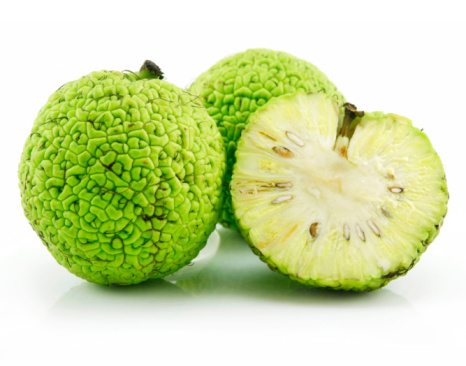

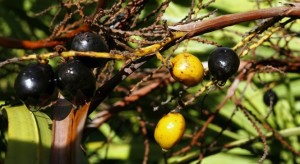
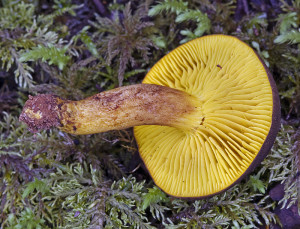
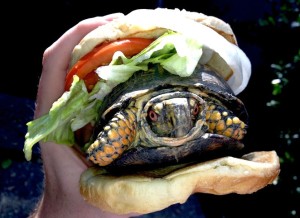

I have to ask, what’s with the goat tree? lol
The goats are foraging. On my website on the instructor page any instructor that does not want to use a picture I use a picture of a foraging goat I took in Greece.
My grandmother was a healer and forager. She used plametto berries in many of her concoctions she would ‘dose’ us with. I have eaten them and used berries in infusions and tinctures. I am knowledgeable about the plametto berries but my question is wheather the larger black berries of the Sabal Palm can be used in similar fashion. Please advise.
You have me a bit confused. The fruit of the Sabal Palm (Sabal palmetto) is about pea size, much smaller than the saw palmetto.
Dr. Charles Allen lives in Central Louisiana. He wrote the book Edible Plants of the Gulf South and I know he gives talks on edible wild plants. I have managed to miss each of the few times he has been in my area, sadly, but I believe he is an in demand speaker on that topic and others. Here is his website: http://www.nativeventures.net/ I noticed that the state of Louisiana doesn’t even show up on your list 🙁 so maybe this will correct that.
I know of Dr. Allen and have his book. He hasn’t asked to be put on the list. Some teachers don’t want people contacting them for classes. They prefer to make their own arrangements as it suits them.
Thanks for bringing a bit of fun along with knowledge.
Unfortunately I’de already accepted a work assignment before I saw what do you’de be in West Palm Beach, I will just have to catch you on your next trip here (and since I’m not tolerant of heat maybe that’s good thing!) DH and I were up in Martin County at the courthouse a few weeks ago and I was marveling at the size and vigor of the cocoplums- and how large the glossy dark fruit was too. I couldn’t resist sampling a cocoplum (large pits, but the fruit was tasty) And then we walked past a sign Proclaiming “Using Reclaimed Water”…agh! thppt! 🙂 Haven’t come down w/cholera yet…:)
greetings! i love the goat tree, really appreciate the info on saw palmetto berries, and am open to learn more about mushrooms. if only i could identify edible ones… ahhh. thank you and i wish you bliss!
i saw a lontar palm in broome, and thought that it must be related closely to the saw palmetto